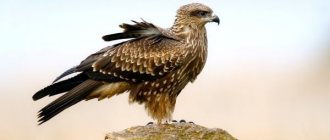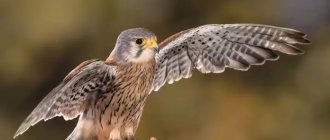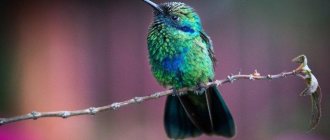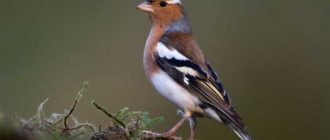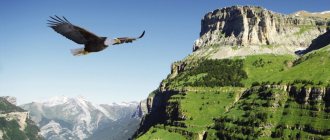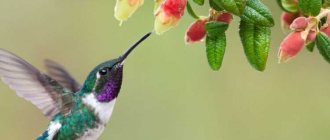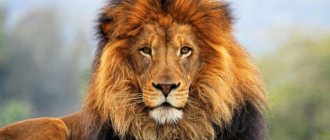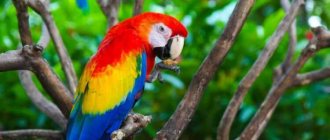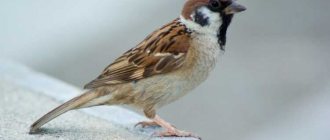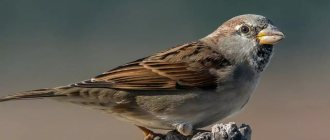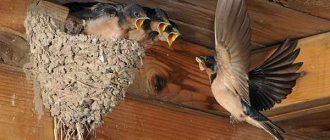Review author: “ZooVita”
The falcon bird of prey belongs to the falcon family and is one of the youngest groups of feathered predators. The falcon left its mark on the cultural heritage of many countries, particularly in the Russian Federation, where it symbolized honor and courage.
The pharaohs considered this bird their patroness. A more detailed description of the falcon bird will help to understand the features of its life.
External fork bird falcon
The photo of the falcon bird shows its powerful wings and body endowed with developed muscles, with the help of which the predator can reach flight speeds exceeding 300 km/h. Its wings are sickle-shaped, which is why its Latin name - Falco - appeared.
The size of the falcon and the structure of its body are all designed to give it the best hunting skills - speed and power. The body length is about half a meter, and the wingspan is more than a meter. The weight and size of females is almost twice that of males.
The wide, powerful wing has a length of up to forty centimeters. The structure of the flight feathers distinguishes adults from young ones, in which they are less developed and have to use them all at the same time
A falcon can spot its prey from a distance of a kilometer using its amazing vision.
The bird has a curious hook-shaped beak, which is crowned with a sharp tooth. Due to this feature, when a falcon attacks small birds, it quite easily breaks their spine.
Rigid, tightly pressed feathers to the body, which help in gaining speed, have a variegated color. The main shades are brown and gray, but almost entirely white or black individuals are found.
The color contains black spots located on the flight feathers, as well as various patterns and white inclusions. The falcon's head is decorated with a “black cap”.
The bird displays its voice during the breeding season, but is silent at other times. The falcon's cry, loud and sharp, is used by it to attract attention and communicate with relatives.
The bird's lifespan is about fifteen years.
Habitat of the falcon bird
In the photo of the falcon bird, it is shown in its natural habitat, which is extremely extensive. It can be found on almost every continent of the globe. Predators live in steppes and semi-deserts, as well as in mountains and coastal areas.
The majority of species adhere to a certain territory, changing it only in search of food. An exception is the peregrine falcon, which is characterized by a nomadic lifestyle. Only young individuals of the predator move to spend the winter, while adults live near water bodies in winter.
It often settles near human settlements, as it has no fear of people.
Where does the falcon live?
Photo: Kobchik in flight
The habitat of red falcons is truly huge. Birds feel great throughout the entire territory of the Eurasian continent, from Ukraine and Poland to the banks of the circumpolar Lena River. The bird is well adapted to a temperate continental climate, but cannot withstand even light frosts, preferring to spend the winter in warm countries.
A large number of these miniature predators are found in the Balkan countries, Kazakhstan and even in the territories of the subpolar Urals. In addition, a separate species of bird, the Amur falcon, lives in the Far East and feels great in the Daurian steppes. Birds choose open areas for their residence. Most of all, red falcons like to settle in fields, in forest-steppes, and also near vast agricultural lands. Also, birds can be seen near the swamps, where a huge variety of insects live.
The only place where the falcon will never settle is large forest areas. This is due to the fact that the falcon has poor maneuverability and is not suitable for flying between trees. In addition, in the open air it is easier to catch insects, which this bird feeds on. In winter, falcons migrate to Africa or southern Asian regions. But they do not build nests in warm countries, preferring to breed in Europe.
Now you know where the falcon is found. Let's see what he eats.
Bird species falcon
The genus of falcons is extremely numerous and includes forty subspecies, divided into the following groups:
Falcon - kestrel
Small birds with red plumage on a dense body. These gray predators are found in Africa. The prey is mainly small rodents.
Falcon - hobby
The five species of this group of birds have dark gray plumage and are quite large in size. It lives in Eurasia and on the coast and islands of the Mediterranean Sea. Also lives on the African continent. Mainly prefers plains, but is also found in the mountains.
Falcon - turumti
Lives in India and Africa. Selects steppes, semi-deserts and savannas as habitat areas. It reaches a length of 35 centimeters, with a wingspan of no more than 85 centimeters. A characteristic feature is the brick-red “cap”.
Falcon
Small wide-winged falcon. Males have almost black plumage, while females are buff with stripes. Adults are distinguished by a red ring around the eyes.
The diet mainly consists of large insects, less often small rodents. They nest in colonies of up to one hundred pairs of birds. The falcon is characterized by school migration.
Falcon - merlin
The small predator has relatively short wings, the span of which ranges from 50 to 70 centimeters. Plumage color and size vary greatly depending on the habitat. Flight is characterized by speed and maneuverability. It hunts mainly low above the ground.
Falcon - laggar
Refers to large falcons. Hunts both birds and hares. It lives in open spaces and makes nests on rocks and ground. Since ancient times it has been used for falconry.
Falcon - saker falcon
Lives in the Russian Federation, Kazakhstan and Central European countries. Belongs to a group that prefers a nomadic lifestyle. In all habitats, the Saker Falcon population is extremely small.
Falcon - gyrfalcon
The largest representative of the falcon. The span of the most powerful wings reaches 135 centimeters. It has a light color, varying from brown-gray to almost white. To achieve high flight speed, a gyrfalcon only needs a few flaps of its wings.
Falcon - peregrine falcon
Inhabits all over the Earth, with the exception of Antarctica. It is the fastest bird of all existing in the world, capable of reaching flight speeds of more than 320 km/h. Divided into seventeen subspecies. Listed in the Red Book of the Russian Federation.
Sosokl - Shahin
The wingspan is no more than one meter. Weight no more than half a kilogram. It lives in the deserts and foothills of Africa and the Middle East, the mountains of Kazakhstan and Southern Altai. Likes to settle close to humans in foothill areas.
What does a falcon eat?
Photo: Falcon bird
As mentioned above, the main diet of falcons consists of large insects.
The bird hunts with pleasure:
- locusts;
- large butterflies;
- dragonflies;
- Zhukov;
- bees and
Falcons are equally capable of hunting in the air, grabbing prey with their beak, and on the ground, picking up insects with strong paws. Miniature falcons feel great in the air and are able to catch even the smallest prey. While feeding the chicks or if there is a catastrophic shortage of insects, falcons begin to hunt small mammals or small birds. It is not uncommon for falcons to catch sparrows, pigeons and wagtails, and also catch mice and lizards.
If the need arises, falcons can feed on carrion and even eat food from the human table, but such a change in diet has an extremely negative effect on the health of the birds and their life expectancy. The fact is that the falcon's body is designed in such a way that it constantly needs large amounts of protein, which is present in insects. And if a bird starts eating other food, then its body does not have enough protein, which leads to serious health problems.
Zoos are struggling with this problem by adding insects (in particular large Madagascar cockroaches) and special vitamin complexes with a high protein content to the food of falcons.
Falcon bird feeding
Being a predator, the falcon feeds on any prey that is smaller than itself. Including: fish, reptiles, rodents, birds and insects. Having outlined a hunting target for itself, the bird does not give it any opportunity to escape.
The falcon eats its prey entirely to obtain all the microelements its body needs. After some time, the predator regurgitates some of the undigested food.
Natural enemies of red falcons
Photo: What a falcon looks like
Falcons have no sworn enemies in the wild. Naturally, four-legged predators such as foxes, badgers, wolves or raccoons will not refuse to feast on eggs or eat young chicks, but this can be fraught with danger for the predator itself.
The peculiarity is that falcons are birds with a highly developed social system that live in groups. And if the clutch or chicks are in danger, then all adult birds will protect their own.
Even a large predator cannot resist the massive attack of miniature falcons. In the scientific literature (as well as in documentaries) there are plenty of examples of how a group of birds drove away such large predators as a wolf or a fox from their nesting area.
It is also not easy for winged predators such as eagles or hawks to catch falcons, which demonstrate wonders of resourcefulness in the air. The greatest threat to birds is people. Firstly, birds are often shot by beekeepers. The fact is that falcons can settle not far from large apiaries and consistently and daily destroy the bee population. Secondly, modern pesticides and other toxic substances used to poison insects pose a great danger to birds. Birds often catch insects and end up getting sick or dying themselves.
Behavioral characteristics of the falcon bird
The falcon has an intelligence that greatly exceeds that of other birds of prey. In addition, endowed with speed and power, the bird often shows its superiority not only to its victims, but also to other winged predators, teasing and playing with them.
The morning and evening hunting preferred by the predator is extremely curious. Often the falcon deliberately lifts its prey from the ground in order to then attack it in the air. It will attack from above, striking with its powerful beak. Such a blow is usually enough to kill feathered prey. During the day, the falcon rests in secluded places, digesting food.
Birds nest on the tallest trees or rocks. Sometimes they can occupy other people's nests, but they do this extremely rarely, due to the location of the nests of other birds in inappropriate places.
Saker Falcon
The saker falcon is a small bird of prey of the falcon family, most common in Russia and Kazakhstan. It can also be found in Siberia, Transbaikalia, Middle and Central Asia, and some parts of Europe. It is a nomadic bird with a small population, so in some places reserves have been created for its breeding.
Translated from the Siberian dialect, the word “saker falcon” is translated as “big hawk.” It is found in Preobrazhensky's dictionary. Another meaning is also possible. If we rely on Turkic languages, then it means “big, fighter, strongman.”
The Saker Falcon's diet mainly includes small mammals and large lizards. Can catch birds such as pigeons, partridges, hazel grouse and others.
Eggs are usually laid on rocks and hills, where they occupy other people's nests. During incubation, the female sits on the eggs, and the male hunts and feeds the family. The chicks make their first flight a month and a half after birth.
Falcon breeding
Pairs formed by a male and female falcon exist throughout their entire lives, since the predator is monogamous. Their mating season begins at the end of winter and lasts for six months. The couple performs an amazing mating dance in the air, after which, clinging their claws, they dive down several tens of meters.
The falcon is very responsible about building a nest and choosing a place for it, choosing secluded safe places for it. The number of eggs in a clutch, which the parents incubate alternately, depends on the size of the female and does not exceed four.
The chicks live under the constant protection of their parents for only one month, after which they must leave the nest. Falcons reach full maturity after one year of life.
